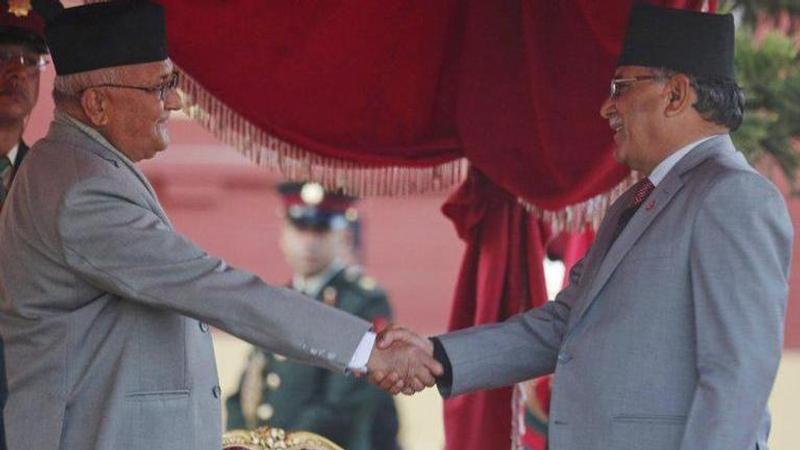Published 16:51 IST, July 8th 2020
Power tussle in Nepal ruling party as China influence grows
Nepal’s prime minister could be forced out of office within weeks amid an internal tussle for power within his governing party following his sharp rhetoric on neighboring India and as Chinese influence grows in the country.

Advertisement
Nepal’s prime minister could be forced out of office within weeks amid an internal tussle for power within his governing party following his sharp rhetoric on neighboring India and as Chinese influence grows in the country.
Prime Minister Khadga Prasad Oli was set to meet Wednesday with his Nepal Communist Party rival, Pushpa Kamal Dahal, who argues it is his turn to rule, ahead of a series of party meetings in coming days and weeks that will decide whether Oli is removed from his post.
Oli’s troubles within the party also come as he deals with blowback from India over a new map of the Himalayan country that includes a disputed area claimed by both India and Nepal.
Kathmandu's relations with New Delhi only worsened after Oli said last week that India was attempting to oust him from office with help from some of the members of his own party.
India had been a dominant force in Nepal until recently, when China’s involvement began to grow. Besides China's investment in the building of airports, highways and hydro-power projects in Nepal, Chinese diplomats have worked to increase ties with Nepali political leaders.
Just this week, China's ambassador to Nepal held meetings with some top Nepal Communist Party leaders.
India's and China's bids for influence in Nepal are part of a greater regional power struggle that is also playing out in a disputed border region in the Karakoram mountains, where diplomats and military commanders worked this week to disengage troops from a deadly standoff between the Asian giants. A June 15 clash along the undemarcated border left 20 Indian soldiers dead, and was the worst violence between India and China in 45 years.
China views Nepal as key to its massive transcontinental infrastructure Belt and Road Initiative that builds on old Silk Road routes that once connected China to the West, analysts say.
“Because Nepal remains in a strategic geographic location, both of these countries think they have to have importance in Nepal’s politics,” said Guranaj Luitel, editor of Nepal's popular Nagarik newspaper.
“The present government looks more inclined toward China, and because of that India's role looks like it's gradually declining,” he said.
India has been wary of Nepal since a Communist government was elected in 2017, but officials deny China’s involvement in internal matters.
“Because there is a Communist government in Nepal, Indian leadership think Nepal is guided by the Chinese, which is not true at all,” said Birod Khatiwada, a member of the Nepal Communist Party central committee.
Oli was elected prime minister in 2017 after the Nepal Communist Party won a majority of the seats in parliament. Just before the general election, two Communist parties led by Oli and Dahal had merged to become a stronger political force.
It was widely believed that Oli and Dahal would split the prime minister’s five-year term, with each taking turns in office. But 2 1/2 years after taking power, Oli has shown no signs of stepping down.
“Having differences and feuds among the leadership or members is nothing new in our political party, but this time it has turned into a national crisis because we are the largest party and we are in the government,” said Khatiwada.
Throughout his tenure in office, Oli has remained a strong and popular leader within the party and in public, despite street protests over the government’s handling of the coronavirus.
He has also gained widespread popularity since presenting the new map that included the disputed territory.
16:51 IST, July 8th 2020




